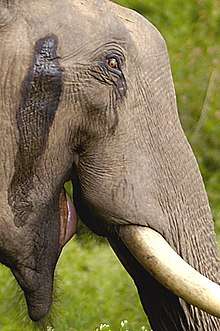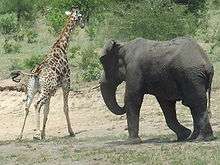Musth
Musth or must (/ˈmʌst/; Urdu: مست, from Persian, lit. 'drunk') is a periodic condition in bull (male) elephants characterized by highly aggressive behavior and accompanied by a large rise in reproductive hormones.


Testosterone levels in an elephant in musth can be on average 60 times greater than in the same elephant at other times (in specific individuals these testosterone levels can even reach as much as 140 times the normal).[1] However, whether this hormonal surge is the sole cause of musth, or merely a contributing factor, is unknown.
Scientific investigation of musth is problematic because even the most placid elephants become highly violent toward humans and other elephants during musth.
Cause

Although it has often been speculated by zoo visitors[2] that musth is linked to rut, it is unlikely there is a biological connection because the female elephant's estrus cycle is not seasonally-linked, whereas musth most often takes place in winter. Furthermore, bulls in musth have often been known to attack female elephants, regardless of whether or not the females are in heat.
Effects
Secretions
Elephants in musth often discharge a thick tar-like secretion called temporin from the temporal ducts on the sides of the head. Temporin contains proteins, lipids (notably cholesterol), phenol and 4-methyl phenol,[3][4] cresols and sesquiterpenes (notably farnesol and its derivatives).[5] Secretions and urine collected from zoo elephants have been shown to contain elevated levels of various highly odorous ketones and aldehydes.
The elephant's aggression may be partially caused by a reaction to the temporin, which naturally trickles down into the elephant's mouth. Another contributing factor may be the accompanying swelling of the temporal glands. This presses on the elephant's eyes and causes acute pain comparable to severe root abscess toothache. Elephants sometimes try to counteract this pain by digging their tusks into the ground.
Behavior
Musth is linked to sexual arousal or establishing dominance, but this relationship is far from clear. Wild bulls in musth often produce a characteristic low, pulsating rumbling noise (known as "musth rumble") which can be heard by other elephants for considerable distances. The rumble has been shown to prompt attraction and reply vocalizations from cows in heat, but silent avoidance behavior from other bulls (particularly juveniles) and non-receptive females, suggesting an evolutionary benefit to advertising the musth state.[6][7]
Cases of rogue elephants randomly attacking native villages or goring and killing rhinoceroses without provocation in national parks in Africa have been documented and attributed to musth in young male elephants, especially those growing in the absence of older males. Studies show that reintroducing older males into the elephant population of the area seems to prevent younger males from entering musth, and therefore, stop this aggressive behavior.[8][7][9]
In domesticated elephants
A musth elephant, wild or domesticated, is extremely dangerous to both humans and other elephants. In zoos, bull elephants in musth have killed numerous keepers when a normally friendly animal became uncontrollably enraged. In contrast to normal dominance behavior, bulls in musth will even attack and kill members of their own family, including their own calves. Zoos keeping adult male elephants need extremely strong, purpose-built enclosures to isolate males during their musth, which greatly complicates the expense of attempting to breed elephants in zoos; most zoos that keep a single elephant or a small herd typically have only females for this reason.
In India, domesticated elephants in musth are traditionally tied to a strong tree and denied food and water, or put on a starvation diet, for several days, after which the musth passes. Mahouts are often able to greatly shorten the duration of their elephants' musth, typically to five to eight days; sedatives, like xylazine, are also used.
The approved method in developed countries is to strictly isolate the elephant in a highly fortified secure pen for a period ranging from 1 to 2 months until the elephant emerges from musth on its own. Medication for swelling and pain, as well as tranquilizers, are often mixed into the elephant's food. During this one- to two-month period the elephant cannot be trained, allowed outside or permitted to see other elephants, and it must be fed, watered and cleaned by remote methods; it will attack any approaching keeper. Some Indian mahouts decry this method as crueler than simply starving and dehydrating the animal for a week, after which it recovers and can be safely reunited with the herd.
Etymology
In modern usage in Indian languages the word refers to a state of enjoyment, fun, pleasure or gratification—of any kind, experienced by humans or other creatures. In popular culture, the word is encountered frequently, in popular song lyrics, in the titles of Indian TV shows and in the titles of Indian movies, such as Mast, Masti, etc.
References in popular culture
References to elephants in musth (whose temporin secretion is often referred to as "ichor") are frequent in classical Indian poetry and prose; for example, in the Raghuvaṃśa, Kalidasa says that the king's elephants drip ichor in seven streams to match the scent put forth by the seven-leaved 'sapta-cchada' (= "seven-leaf")[10] tree (perhaps Alstonia scholaris). Some poets turn it around to compare the elephant's ichor to the "saptacchada". The phenomenon has been described in poetry much before the time of Kalidasa, in Sanskrit, Tamil and Pali literature.
Shooting an Elephant is an autobiographical account by George Orwell in which he describes how an elephant in Burma had an attack of musth and killed an Indian, which in turn, caused the death of the elephant.
Sangam poetry describes musth. Kummatoor Kannanaar in Pathitrupatthu 12 describes it as follows:
It was sweet to hear of your victories and fame
and I came here desiring to see you.
I came with my big family, passing few mountains
where noble, young male elephants with coarse hair
and swaying walks have musth flowing from their
cheek glands and elephant mothers with calves
wave wild jasmine twigs,
chasing striped bees that swarm on the sweet musth.[11]
The Tamil movie Kumki, which revolves around a mahout and his trained elephant, shows his elephant in musth period towards the climax. Captive elephants are either trained for duties in temples (and in cultural festivals), or trained as a Kumki elephant which confronts wild elephants and prevents them from entering into tribal villages. Elephants trained for temple duties are of a gentle nature and cannot face wild elephants. In this movie, a tribal village wants to hire a Kumki elephant to chase away wild elephants which enter the village every harvest season. The mahout, who is in want of money, takes his temple-trained elephant to do this job, in the vain hope that wild elephants won't come in. But wild elephants start attacking the village on the harvest day. The temple-trained elephant gets into musth and thus fights with the wild elephants, kills the most notorious among the herd, and dies from injuries sustained during the fight.
In his James Bond novel The Man With the Golden Gun, Ian Fleming wrote that the villain, Francisco Scaramanga, was driven to become a cold-blooded assassin after authorities shot an elephant that he had ridden in his circus act, after the elephant went on a rampage while in musth.
In Jules Verne's Around the World in Eighty Days, Phileas Fogg buys an elephant which was being fed butter, so it would not go into musth.
References
- Rasmussen, Lois E.; Buss, Irven O.; Hess, David L.; Schmidt, Michael J. (1 March 1984). "Testosterone and Dihydrotestosterone Concentrations in Elephant Serum and Temporal Gland Secretions". Biology of Reproduction. 30 (2): 352–362. doi:10.1095/biolreprod30.2.352. PMID 6704470.
- "Musth of the elephant bulls – Upali.ch".
- Physiological Correlates of Musth: Lipid Metabolites and Chemical Composition of Exudates. L.E.L Rasmussen and Thomas E Perrin, Physiology & Behavior, October 1999, Volume 67, Issue 4, Pages 539–549, doi:10.1016/S0031-9384(99)00114-6
- Musth in elephants. Deepa Ananth, Zoo's print journal, 15(5), pages 259–262 (article Archived 2018-06-04 at the Wayback Machine)
- Sukumar, R (2003). The living elephants: evolutionary ecology, behavior, and conservation. USA: Oxford University Press. p. 155. ISBN 9780195107784. Retrieved 2010-12-25.
temporin elephant.
- "Killing of black and white rhinoceroses by African elephants in Hluhluwe-Umfolozi Park, South Africa" by Rob Slotow, Dave Balfour, and Owen Howison. Pachyderm 31 (July–December, 2001):14–20. Accessed 14 September 2007.
- Siebert, Charles (2006-10-08). "An Elephant Crackup?". New York Times Magazine. Retrieved 2007-06-16.
- "Killing of black and white rhinoceroses by African elephants in Hluhluwe-Umfolozi Park, South Africa" by Rob Slotow, Dave Balfour, and Owen Howison. Pachyderm 31 (July–December, 2001):14–20. Accessed 14 September 2007.
- "Older Bull Elephants Control Young Males" by Bruce Page, Joyce Poole, Adam Klocke, G. Van Dyk, and R. Slotow. Nature 408 (23 November, 2000). Accessed 19 July 2019.
- "Saptacchada". venetiaansell.wordpress.com. Missing or empty
|url=(help) - https://learnsangamtamil.com/pathitrupathu/ acc: 3/12/17
External links
| Wikimedia Commons has media related to Musth. |
| Look up musth in Wiktionary, the free dictionary. |